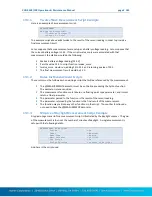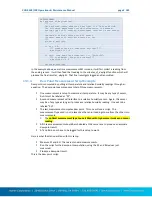
XLINK 500/100 Operations & Maintenance Manual page # 167
measurement in seconds, and the last digit is the number of data values returned. Wait for the
number of seconds. Then issue the aD0! (address, D, zero, !) the sensor should respond with one
or more data values. You may issue further aD1!
…
aDn! till you get all of the data.
If the SDI sensor is version 1.3 (version number can be found out by sending the ?I! command;
the version is returned as the second and third characters of the response), then make sure to
use the CRC measurement commands. These commands work just like normal measurement
commands, except that they use an error checking mechanism that minimizes errors. So, instead
of 0M!, use 0MC!. Instead of 0M1!, use 0MC1!. This will ensure reliable SDI communication.
17.6.
SDI Clock Synchronization
Certain Sutron SDI-12 sensors (such as the SDR, RLR, and the CF Bubbler) support a command to
set the time of the sensor via SDI-12. The system takes advantage of that feature, and
periodically sets the clock of the sensors using an SDI-12 command, ensuring that all devices
share a common time.
When recording is enabled, and every 24 hours thereafter, the station performs a time sync with
all the Sutron devices that support the XDT! command. The time sync is started by sending an I!
command to every SDI-12 device that has been set up. If the device replies favorably to the I!
command, an XDT! command is issued to the device. The system then decides whether to sync
that dev
ice’s clock based on the time difference between
the system and the device.
This process is automatic and cannot be disabled.
The XDT set time command takes the format
aXDTYYYY/MM/DD HH:MM:SS!
a is address
XDT is the command to set the date and time
YYYY is the year
MM is the month (01 to 12)
DD is the day of the month (01 to 31)
HH is the hour (military time 0 to 23)
MM is the minutes
SS is the seconds
Example set date time command:
0XDT2017/07/26 11:15:34!
















































